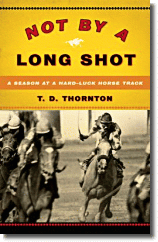
He applied the "Page 99 Test" to his book Not by a Long Shot: A Season at a Hard Luck Horse Track, and reported the following:
When an email landed in my inbox with a request to challenge Not by a Long Shot to the infamous “Page 99 Test,” I was hesitant to crack the spine of the book to see what was there: It was eerily like fooling around with a Ouija board — such an outlandish concept, but still….Read an excerpt from Not by a Long Shot and learn more about the book at the publisher's website.
Truth be told, the Page 99 Test does work for Long Shot. Sort of. You have to sift and squint a bit, but it’s there.
Not by a Long Shot is a nonfiction narrative detailing the glorious underbelly of horse racing, openly challenging the myth that the game is the regal and royal Sport of Kings. In reality, racing’s most gripping tales come from obscure racetrackers who toil under the radar, and page 99 in the first hardcover edition underscores that notion in caustically honest fashion.
In writing Long Shot, I tried to juxtapose different viewpoints alongside one another. The result (hopefully) is that the reader sees the sport through a clash of divergent perspectives. The top of page 99 wraps up a section in which the general manager of a hard-luck horse track in New England is trying to convince the industry’s biggest trainers to run their star, million-dollar Thoroughbreds in a race of historic significance at his downtrodden racecourse. “I mean, why wouldn’t these guys want to come back…” is his wishful summation of a somewhat desperate, bleak proposition that only he believes can be parlayed into an embarrassment of riches.
After the section break, a new storyline emerges that chronicles the quirky, offbeat idiosyncrasies of the grizzled, gritty denizens of that same venue, where “the atmosphere resembles a freaky circus sideshow” populated by “two distinct types of Boston racetrack personalities: Scary-looking regulars, who are, in fact, totally harmless, and another subset of souls who are, without a doubt, truly troubled.”
These bit players are not just cogs of a single, struggling horse track. They are the unseen supporting cast for an entire $15 billion betting industry. The way these raucously Runyonesque characters play the game might not be the prettiest, but it’s as close to reality as you’re going to get in horse racing literature. The fact that small-time racing remains alive at minor league tracks all across the country has to count for something, and that “something” is embodied in page 99 of Not By A Long Shot.
Page 99:
…Behrens and Running Stag, the one-two finishers from last year. Back again. In Boston. MassCap 2000.”
The Suffolk Downs racing boss pauses briefly in his rapid-fire delivery and I get a mental picture of Lou standing in the sunny Florida paddock, impeccably dressed in one of his custom suits, framing words with outstretched hands on an invisible marquee, scheming and dreaming for a race that is most definitely his baby, a MassCap that is three months away at a racetrack currently sleeping under the dark chill of winter and a brittle crust of snow.
“Think about it,” he continues, slowing down as if considering all the other plausible scenarios before snapping back to the first notion that entered his head. “I mean, why wouldn’t these guys want to come back to Suffolk Downs?”* * *
On a bright mid-winter Sunday I am cruising through Legends, the stale, dank, paradoxically named sports bar on the second floor of Suffolk Downs. Phlegmy coughs and foul language rule here, and the atmosphere resembles a freaky circus sideshow. Over the past decade, the room has come to attract two distinct types of Boston racetrack personalities: Scary-looking regulars who are, in fact, totally harmless, and another subset of souls who are, without a doubt, truly troubled.
Thanks to the public’s demand for increased smoke-free space elsewhere in the track, Legends has also become a concentration of carcinogens, one of the few remaining areas where lighting it up is not only permitted, but enthusiastically encouraged. A thick, blue haze of secondhand tars has tinged the enclosed room’s previously white tiled ceilings a perpetual yellow, its worn industrial carpet is pockmarked with burns, and the large windows that front the clubhouse turn are layered with accumulated cigar and cigarette grime while a liberal spattering of gull droppings ornaments the exterior. When no other passage through the building is convenient, I try to rush through the room as quickly as possible because the stagnant cloud of exhaled tobacco instantaneously permeates one’s clothes, hair and eyes; an unwelcome accompaniment that will linger for the remainder of the day…
--Marshal Zeringue



